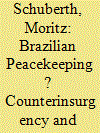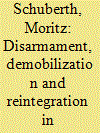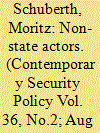|
|
|
Sort Order |
|
|
|
Items / Page
|
|
|
|
|
|
|
| Srl | Item |
| 1 |
ID:
166785


|
|
|
|
|
| Summary/Abstract |
Brazil’s role in UN peacekeeping operations has been subject to increasing attention from academics and policy makers alike. While some authors praise Brazil’s engagement in the United Nations Stabilization Mission in Haiti (MINUSTAH) as a case of innovative South-South cooperation, others accuse Brazil of using Haiti as a ‘testing ground’ for repressive anti-gang tactics that have subsequently been introduced at home. This article challenges these two dominant views on Brazil’s role in Haiti. Based on a period of six months of fieldwork in Port-au-Prince and interviews with key Brazilian actors, the article draws a parallel between MINUSTAH’s military raids in gang-ruled neighbourhoods coupled with police reform in Haiti, on one hand, and the Pacifying Police Units (Unidade de Polícia Pacificadora) plus the accompanying UPP Social in Rio de Janeiro, on the other hand. It is argued that Brazil’s peacekeeping strategy, at home and abroad, is a mix of coercive and cooperative measures reminiscent of counterinsurgency (COIN) tactics already employed during the French colonial war in Algeria. Moreover, it is shown that policing techniques borrowed from the US are employed to ease the tension between carrots and sticks, notably so in the urban environment in which Brazilian peacekeeping is taking place.
|
|
|
|
|
|
|
|
|
|
|
|
|
|
|
|
| 2 |
ID:
153528


|
|
|
|
|
| Summary/Abstract |
Disarmament, demobilization and reintegration (DDR) programmes form part of standard post-conflict peacebuilding tools regularly applied in the context of UN peacekeeping operations. Yet, the limitations of such templates become evident when peacebuilders are confronted with unconventional settings, such as the urban environment. So far, there is a scarcity of research on UN-led DDR efforts in cities, even though the proliferation of urban armed groups is projected to pose an intractable challenge for decades to come. Based on six months of fieldwork in Port-au-Prince, this article presents new empirical evidence on innovative DDR programming in Haiti, the only country where a United Nations Stabilization Mission (MINUSTAH) tried to implement a traditional DDR programme for gang members. As this attempt proved to be a failure, the mission subsequently changed its approach to a more community-focused armed violence reduction and prevention programme which aims to disincentivize at-risk sections of the population from joining gangs. Even though the current community violence reduction approach is better adapted to the unconventional conflict environment in Haiti and is seen by many practitioners today as a role model, it shares a number of limitations with traditional DDR programmes and is not a panacea for urban peacebuilding.
|
|
|
|
|
|
|
|
|
|
|
|
|
|
|
|
| 3 |
ID:
140340


|
|
|
|
|
| Summary/Abstract |
The proliferation of irregular armed actors which defy simplistic definition has caught public and academic attention alike, not least in the pages of this journal. To move the debate on non-state armed groups (NSAGs) forward, this article seeks to enhance our conceptual understanding of parochial armed groups which are not primarily driven by ideological or religious objectives. Thus, this article clarifies similarities as well as differences between subtypes of community-based armed groups (CBAGs) on the one hand, and between CBAGs and other NSAGs, on the other hand. By doing so, a typology is developed that classifies militias, gangs and vigilantes on the basis of their political, economic and security-related dimensions. The resulting ideal types are discussed through the lenses of different explanatory frameworks and policy debates in the field of contemporary security studies. A major typological issue is the tendency for CBAGs to ‘turn bad’ and become threats to the stability they were expected to transform, becoming a serious problem in countries where they operate. It is concluded that the challenge of CBAGs ultimately needs to be addressed by putting in place a functioning state that can tackle the underlying woes that led to their proliferation in the first place.
|
|
|
|
|
|
|
|
|
|
|
|
|
|
|
|
|
|
|
|
|